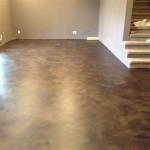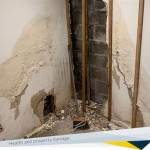Getting Rid of Mold on Concrete Basement Walls
Mold growth on concrete basement walls is a common problem, particularly in areas with high humidity levels. Mold can cause health problems and damage your home, making it crucial to address this issue promptly. This article discusses how to safely and effectively remove mold from your basement walls, addressing the issue from identification to prevention.
Identifying Mold
Before attempting to remove mold, it's essential to correctly identify it. Mold appears in various colors, including black, green, white, and orange. It can also grow in patches or spread across large surfaces, making it easily visible. Look for signs of dampness, musty odors, and discoloration on your basement walls, floors, and ceilings. If you suspect mold growth, use a mold test kit to confirm its presence. While some types of mold are harmless, others are toxic and require professional intervention.
Removing Mold from Concrete Basement Walls
Once you've identified mold, it's time to address its removal. Mold removal requires a multi-pronged approach, including cleaning, drying, and preventing future growth. Always wear protective gear, including gloves, a mask, and eye protection when working with mold. Here's a comprehensive guide for removing mold from concrete basement walls:
1. Prepare the Area
Before starting the cleaning process, prepare the area by removing any loose items or furniture. This includes covering nearby surfaces with plastic sheeting to prevent mold spores from spreading. Open windows and doors for ventilation to improve air circulation and reduce moisture levels. Protect yourself by wearing a mask and gloves to avoid inhaling spores.
2. Clean the Affected Area
Use a solution of water and bleach to clean mold from the affected area. Mix one cup of bleach with one gallon of water in a spray bottle. Spray the solution liberally onto the moldy area, ensuring it's completely covered. Let it sit for 10-15 minutes before scrubbing with a stiff-bristled brush. Rinse the area thoroughly with clean water and allow it to dry completely. You can also utilize commercial mold cleaners available at hardware stores, following the manufacturer's instructions carefully.
3. Dry the Area
Mold thrives in moist environments, so drying the area thoroughly is crucial. Open windows and doors for ventilation, and use a dehumidifier to remove excess moisture from the air. You can also use fans to circulate air in the basement and speed up the drying process. Aim for a relative humidity level below 50%, which is considered optimal for preventing mold growth. If the walls are still wet, you may need to use a drying solution like a fan or dehumidifier for an extended period.
4. Repair Damage
If the mold has damaged the concrete surface, you may need to repair it. This could involve patching cracks or holes in the wall. Use a concrete patch kit to fill any damaged areas, and then let it dry completely before painting or sealing the area.
5. Prevent Future Growth
After cleaning and drying the affected area, it's crucial to prevent future mold growth. Here are some preventive measures:
- Address Moisture Sources
Identify and address any potential moisture sources in your basement, such as leaky pipes, overflowing gutters, or poor ventilation. Repair any leaks promptly and ensure proper drainage around the foundation. Install a sump pump if necessary to prevent groundwater from entering your basement.
- Improve Ventilation
Ensure adequate ventilation in your basement by opening windows or installing exhaust fans. This will help regulate humidity levels and reduce the risk of mold growth. Consider installing a dehumidifier to further reduce humidity levels.
- Seal Cracks and Gaps
Seal any cracks or gaps in your basement walls and foundation to prevent moisture from seeping in. You can use caulk or sealant to seal these areas effectively.
Professional Help
For extensive mold growth or if you're unsure how to handle the situation, it's best to consult a professional mold remediation specialist. They have the expertise and equipment to safely and effectively remove mold from your basement and prevent its recurrence. Professional services are especially recommended if you suspect the presence of toxic mold, which can pose health risks.
By following these steps, you can effectively remove mold from your concrete basement walls and prevent it from returning. Remember to take necessary safety precautions, address the root cause of the moisture problem, and regularly monitor your basement for any signs of mold growth. Prompt action is crucial to protect your health and your home from the harmful effects of mold.

How To Get Rid Of And Prevent Mold Growth On Concrete Environix

How To Remove Mold From Concrete Cleaning Tips Network

How To Get Rid Of And Prevent Mold Growth On Concrete Environix

How To Get Rid Of And Prevent Mold Growth On Concrete Environix

How To Remove Mold From Concrete Basement Walls Doityourself Com

How To Get Rid Of And Prevent Mold Growth On Concrete Environix

How To Get Rid Of And Prevent Mold Growth On Concrete Environix

How To Remove Mold From Concrete 7 Effective Ways

How To Remove Mold From Basement Walls Get Rid Of Molds Concrete Air Quality Express

How To Clean Mold On Basement Walls And Prevent Reoccurrence
Related Posts







